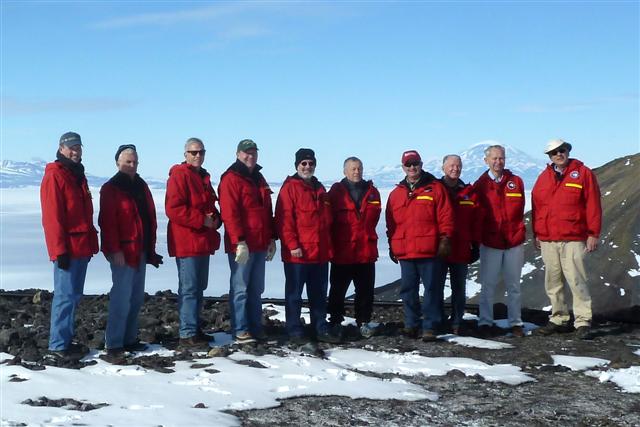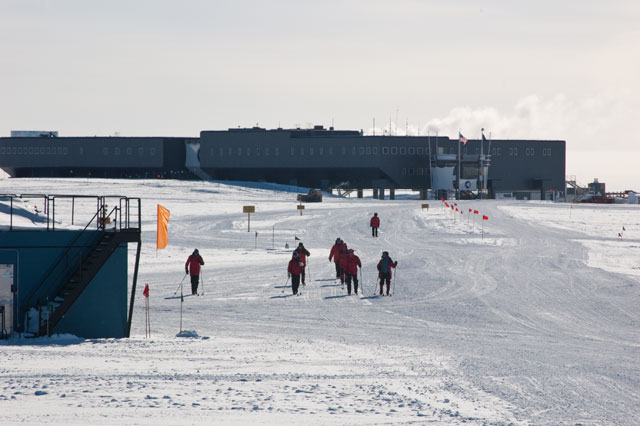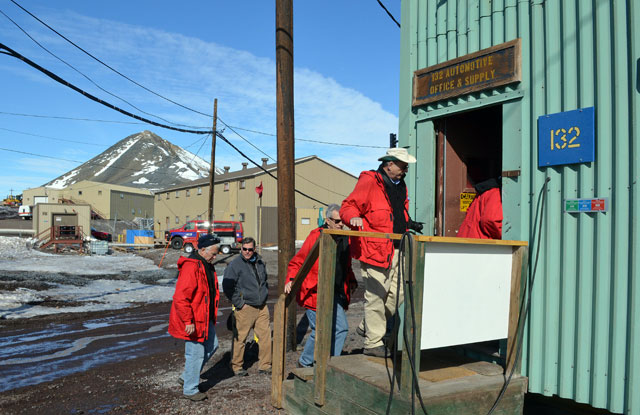Blue Ribbon PanelGroup think tank visits Antarctica to recommend long-term vision for USAPPosted December 30, 2011
Norman Augustine “One is to fix our education system and two is greater investment in research,” said Augustine, former chairman and CEO of Lockheed Martin Corp. It’s that passion for science and technology that has drawn him once again to Antarctica, where he and other government, business and academic leaders spent the first week of December visiting the research facilities and field camps maintained by the National Science Foundation (NSF) In 2010, the NSF initiated a comprehensive review of the nation’s research operations on the southernmost continent in collaboration with the White House Office of Science and Technology Policy (OSTP) 
Photo Credit: Peter Rejcek
Members of the Blue Ribbon Panel and NSF officials talk with McMurdo Supply Operations manager Mel Moore, right, about warehousing issues at McMurdo Station.
The process started when a committee under the National Research Council The NRC committee identified long-term research goals that should guide the USAP in the coming decades, calling for a balance between understanding Antarctica’s role in global climate processes and ensuring an emphasis on discovery and basic research. [See previous article Eye on the future: NRC panel recommends implementing Antarctic observation network.) Now it’s the job of the USAP Blue Ribbon Panel “We realize that predicting science is a hazardous business … It often proves to be wrong. The facilities here will long outlast the next generation of science,” noted Augustine while at McMurdo Station Construction of McMurdo Station began in 1955 during a “golden age” of scientific discovery known as the International Geophysical Year More than 50 years and dozens of structures later, McMurdo has grown into the largest research station in Antarctica, home to more than 1,100 people during the sun-filled summer months of October through February. At least one building in McMurdo dates back to the late 1950s. Most of the research projects funded by the NSF and other federal science agencies flow through McMurdo, which is the gateway to field camps across the continent and still the launching pad to its more modernized, sister station at the South Pole. Augustine and the rest of the panel had an opportunity to visit the South Pole Station “It’s such an improvement over the old station. … What a step forward,” said Augustine, making his fourth trip to the Ice. 
Photo Credit: Laura Rip/Antarctic Photo Library
Members of the U.S. Antarctic Program Blue Ribbon Panel at McMurdo Station. They were escorted by National Science Foundation officials Brian Stone and Karl Erb. From left: Stone, Craig Dorman, Bart Gordon, Keith Harrison, Jerry Miller, Gerard Jugie, Duncan McNabb, Erb, Don Hartill and Norm Augustine.
But Augustine noted that the panel’s job is to take a holistic approach in analyzing the different pieces of the USAP, which costs about $265 million a year to operate, not including direct research dollars, which accounted for about $70 million in fiscal year 2011. The USAP comprises McMurdo and South Pole, and a third research facility, Palmer Station “They all impact each other; maybe there’s a saving here that will produce a big benefit somewhere else. I think it’s the big picture where there may be a lot of leverage,” Augustine said. The panel got an opportunity to learn about the bits and pieces not just from touring facilities, field camps and airfields, but also directly from the support personnel and science community at McMurdo during an open meeting. A few themes emerged from the comments made by USAP participants : consolidation of warehouses, a centralized recreation center, and an emphasis on alternative energy. “We have an incredible opportunity to do something very different in the way we generate power at this facility,” noted Blue Ribbon Panel member Keith Harrison, a former executive for more than 40 years at Procter & Gamble “We’re united in believing that this could be — and should be — a place that could lead the way and be a demonstration site for a totally different way of thinking about power generation,” he added. 
Photo Credit: Peter Rejcek
People ski away from the new South Pole Station, which was built after the last Blue Ribbon Panel review in the 1990s.
Augustine repeatedly lauded the workforce charged with managing the warehouses, driving the machinery, cooking the meals, and doing all the other tasks required to run what is basically a small town. “We’ve been impressed with their competence and their ‘can-do’ attitude, particularly with their friendliness and hospitality,” Augustine said. “Everyone we’ve run into has been so helpful.” The panel expects to make its report to the White House and NSF in 2012 after further visits at stateside USAP facilities and Palmer Station. Augustine conceded that the austere budget climate hanging over Washington makes it challenging to expect another project as ambitious as the South Pole Station to emerge in its recommendations. However, he said even difficult economic times don’t necessarily require cuts across the board. An aeronautical engineer, Augustine likened the current economic climate to developing a new airplane that at first is too heavy to fly. Engineers may be forced to redesign or eliminate certain features, but there’s one thing they’ll never cut: “Never did we solve the problem by taking an engine off,” Augustine said. “That’s the message here. … There are ways to reduce weight … but you don’t take the engine off. This place is one of the engines.” Accompanying the panel were Karl Erb, director of the NSF’s Office of Polar Programs |



For USAP Participants |
For The Public |
For Researchers and EducatorsContact UsU.S. National Science FoundationOffice of Polar Programs Geosciences Directorate 2415 Eisenhower Avenue, Suite W7100 Alexandria, VA 22314 Sign up for the NSF Office of Polar Programs newsletter and events. Feedback Form |


